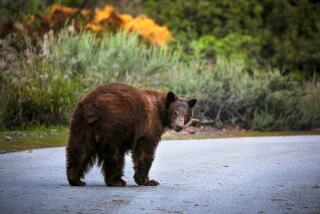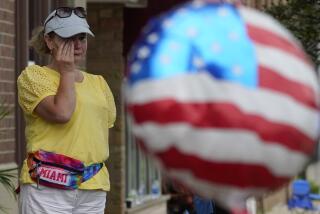Hunting Tragedies Still Happen, but Rate Is Declining
- Share via
In New York state’s nightmarish hunting season of 1991, a man shot his mother and two fathers killed their sons. In each case, the kin were mistaken for deer. One grief-stricken father took his own life.
It all conjures up visions of woodlands flowing with blood, of legions of trigger-happy hunters shooting anything and everything that moves, occasionally taking game, occasionally hitting a friend or relative.
There’s one problem with that scenario. Statistics indicate that it’s not necessarily true.
Accidental shootings have fallen by more than half in the last 20 years, primarily because hunters in 46 states must now pass firearms safety courses to qualify for a license, according to a hunting organization.
“These accidents are a true tragedy,” said Clair Huff, executive vice president of the North American Hunter Education Assn. “It’s just poor judgment by the hunter. By the same token, we have to look at the number of lives we have been instrumental in saving.”
Last year, 99 people were killed by hunters and 47 hunters accidentally killed themselves, according to the association. The toll--the lowest ever, the group says--compares to the 148 combat deaths America suffered in the Gulf War.
By another measure, five times as many people died in recreational boating accidents as lost their lives to hunting mishaps in 1989, according to numbers compiled by the National Safety Council.
There were 1,564 accidental shootings in 1990, or 58% fewer than 20 years ago, Huff said. This figure, he said, is apportioned among all 17 million licensed hunters. Most accidents happen in the pursuit of big game; there is no precise figure just for deer hunters.
Only Alaska, Massachusetts, Minnesota and South Carolina do not have mandatory safety courses for hunters. All states offer voluntary courses.
“Hunting is really not that high-risk. It’s an illusion of public perception,” said Robert Byrne of the Wildlife Management Institute, a Washington-based conservation group.
Anti-hunting forces readily accept that illusion. “On a lot of levels, it’s simply a bloody sport,” said Elliot Katz, president of In Defense of Animals. “In our society (hunting is) barbaric and outdated.”
And it is difficult to explain how a human being can be mistaken, however rarely, for a deer or a bear or a turkey. Yet these accidents happened:
* A distraught Gene Bulak, 41, of Taberg, N. Y., committed suicide Nov. 24 after he discovered he had killed his son, Michael, 18, with a shotgun blast to the head.
* Ignatius Cuttita, 61, of New City, N. Y., shot and killed his 33-year-old son, Craig, on Nov. 30 with a rifle.
* David Joseph Hose, 19, of Tarrytown, N. Y., mistook his mother for a deer and shot her twice in the chest with a .22-caliber rifle on Oct. 22. The woman, 47-year-old Takeko Hose, was pruning a fruit tree in her back yard. She survived, and Hose pleaded guilty to illegally discharging a firearm.
“You can’t explain it, other than to say they just weren’t careful. It boggles me,” said Michael O’Hara, who is in charge of teaching hunter safety in New York. “If all hunters just made sure of their target, we’d eliminate most accidents.”
New York is one of 10 states that do not require hunters to wear blaze orange, which makes them less likely to be mistaken for game. None of those shot was wearing the bright color.
Still, O’Hara said: “Blaze orange isn’t a bulletproof vest.”
Some accidents seem to result from the mind playing tricks.
Three years ago, Karen Wood, 37, mother of twin year-old girls, was killed by a rifle shot to the chest as she stood about 130 feet behind her home in Hermon, Me. She was wearing white mittens. The hunter, Donald Rogerson, thought he saw the white flash of a deer’s tail before he fired the fatal shot. He was acquitted of criminal charges.
“People are shooting at movements, at sounds,” said L. J. Smith, hunter education administrator in Mississippi. “If they took that extra second, then these accidents wouldn’t occur.”
“It’s what’s known as ‘buck fever,’ ” said Bill Allegretti, Delaware’s hunter education coordinator. “You go out in the woods looking for a deer, and you’re going to see what you’re looking for. We try to drill it into people to identify their target before they pull the trigger.”
Those are the grieving sentiments of Kimberly van Tassel of Roseau County, Minn., whose husband, George, was killed while hunting in 1989. He was wearing a blaze orange outfit and was riding a three-wheeler through the woods when another hunter mistook him for a deer.
“If you’re not sure and the deer gets away, isn’t it better than killing someone?” Kimberly van Tassel told the Star Tribune of Minneapolis.
“If you’re not 150% sure through the scope that it’s a deer, then don’t shoot,” she said. “Remember that there’s a loved one of somebody’s out there. Think of that. And be damned sure before you pull the trigger.”
More to Read
Sign up for Essential California
The most important California stories and recommendations in your inbox every morning.
You may occasionally receive promotional content from the Los Angeles Times.










